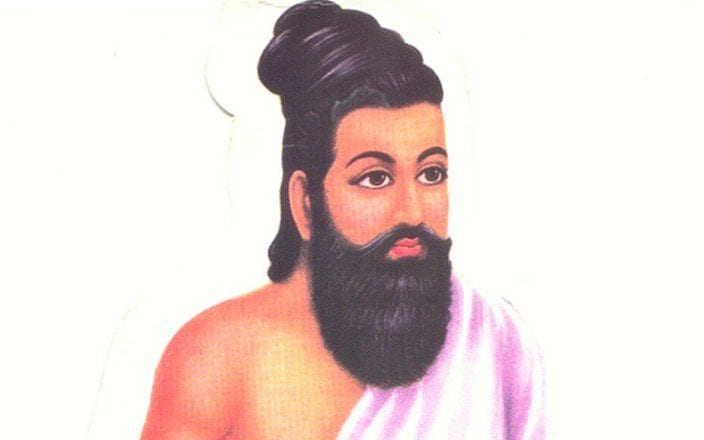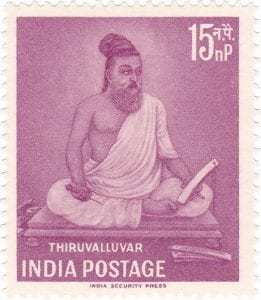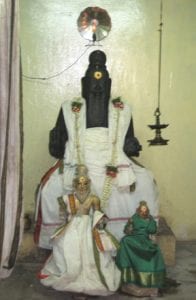
Tamil parties up in arms against 'saffronisation' of Thiruvalluvar
It is strange that the BJP picked up Thirukkural as a vehicle to boost a Hindutva campaign in Tamil Nadu, given the Kural’s (a poetry meter comprising two lines) emphatic message that all human beings are equal at birth and professing values like universal brotherhood.

The BJP’s attempt to “saffronise” Tamil sage-poet Thiruvalluvar, who provided to the world 1,300 fascinating couplets in his work Thirukkural some 2,000 years ago from Mayilapur in present-day Chennai, has come in for sharp criticism from Tamil scholars and needless to say, various political parties in Tamil Nadu.
The Tamil Nadu unit of the BJP, in a tweet soon after Prime Minister Narendra Modi launched the translated version of Thirukural in Thai language, showed Thiruvalluvar in saffron robes as against the customary white dress. Tamil activists are up in arms against painting Thirukkural as a symbol of Hindu religion since there is no reference to any religion or any religious head in the Tamil work.
Also read | Scholars allege BJP trying to appropriate Tamil poet Thiruvalluvar
It is strange that the BJP picked up Thirukkural as a vehicle to boost a Hindutva campaign in Tamil Nadu, given the Kural’s (a poetry meter comprising two lines) emphatic message that all human beings are equal at birth and professing values like universal brotherhood. The couplets have earned admiration all across the world for the message of righteousness, ethics, humanism, and of rising above the tenets of caste, creed, religion or nationality, making it a book that everyone in the world could read and imbibe. No wonder that Thiruvalluvar was praised worldwide for his work that stands as a beacon for mankind in all parts of the globe.

A stamp of Thiruvalluvar in 1960, the Valluvar Kottam and the Thiruvalluvar statues erected in Chennai and Kanyakumari by former chief minister M Karunanidhi during DMK rule, as also the portraits that adorn the Tamil Nadu Assembly or the state-owned buses show him as a sage without any rudraksh, ash or symbol of any religion. On the other hand, the BJP has projected Valluvar as sporting rudraksh and ash on his forehead, giving him a distinct Hindu identity.
There has been a systematic campaign by BJP leaders in the state to project Valluvar as a symbol of Hindu religion. BJP in-charge for Tamil Nadu, Muralidhar Rao, has said that Thirukkural is Hindutva and Hindutva is Thirukkural. Similarly, H Raja, a member of BJP’s national executive committee, said that Thirukkural is based on Hindu Sanatana Dharma principles.
Also read | Judge asks lawyers to recite Thirukkural daily, says all should know 51 at least
The BJP leaders have made liberal use of the views of noted archaeologist, Dr R Nagaswamy, who recently released the book Thirukkural – An Abridgement of Sastras, which claimed that Sanskrit and Vedic influences dominated the Kural. When DMK president MK Stalin criticised Dr Nagaswamy accusing him of being anti-Tamil, Dr Nagaswamy had hit back at him.
Even if the DMK is blamed by the BJP for trying to make a wrong projection of Thiruvalluvar for political purposes, it must be said that what the DMK had done was to often quote from Thirukkural couplets to demonstrate the richness and greatness of the Tamil language. The DMK leaders would thus position themselves as the champion of the Tamil cause.
The fact that the Kural did not reflect views of any particular religion came in handy for the DMK to quote at public meetings. Just as Sanskrit seemed out of bounds for the commoners, the literary and chaste Tamil of the Kural also seemed out of reach of the masses who lapped up the rich Tamil of Thiruvalluvar couplets served at public meetings. In fact, after citing a Kural, the DMK leaders and others would have to translate into a Tamil of current usage. Only then could the people follow the couplets.
It may be noted that Tamil Nadu’s assembly sessions begin with the Speaker reciting a couplet from the Thirukkural and explaining it in modern Tamil. K Balachander, a famous filmmaker from Tamil Nadu, used the opening Kural for the logo of his company.
The popularity of the Thirukkural rose so much over the decades that various religions have tried to project Thiruvalluvar as a follower of their own faith. Hindus, Jains, Christians and Buddhists — all of them claimed Valluvar was ‘one of theirs’. Within the Hindus, there were rival claims from the Vaishnavite and Shaivite sects as well.
Also read | Sitharaman falters while quoting Tamil poet, colleagues correct her
Meanwhile, the Jains pointed out that the Thirukkural emphasised tenets like ahimsa (non-violence), and referred to evils like meat-eating and consumption of liquor, which were relevant to Jainism. Mayilapur was home to a number of Jains nearly 2,000 years ago, it is said, and Tamil language owed a deep debt of gratitude to several Jains for their contribution to Tamil language and literature, especially grammar. Three of the five great Tamil epics, Silapaddikaram, Jivaka Chintamani, and Valayapathi, were by Jains, and therefore the claims of the Jains that Thiruvalluvar was a Jain had some basis.
A group of Christians made out a case that Thiruvalluvar was a product of Christianity but there was little proof of it. However, it must be said that GU Pope, who translated the Tirukkural in English in 1886, was a big champion of the Kural philosophy. In fact, the Pope was one of those who drew attention of Mahatma Gandhi to the Kural. Many believe that Gandhi drew inspiration from the Kural, especially, the emphasis on peace and non-violence, vegetarianism and the concept of returning good for evil, universal brotherhood, rising above caste and religion.
It could be said that the sayings of venerable sages from various religions could have made an impact on Thiruvalluvar, but he steered clear of committing himself to any particular religion. It is also strange that he made no reference to names of prominent Tamils of any era or the kings in Tamil Nadu or anywhere else. Thus, he kept away from political affiliations or from any particular kingdom.
There is no clear evidence about the caste of Thiruvalluvar. However, there are references to him being born in a low caste. A traditional version claims that he was a Paraiyar weaver. Another theory is that he was from the agricultural caste of Vellalars because he extols agriculture in his work. Another states he was an out-caste, born to a Pariah woman and a Brahmin father. Tamil scholar S Vaiyapuri Pillai said he derived his name from “valluvan” (a Paraiyar caste of royal drummers).

Thiruvalluvar was said to have been married to a woman named Vasuki and lived in Mylapore, where a Thiruvalluvar temple exists, though there are doubts that it may not have been a temple for the Tamil sage.
An unseemly controversy has now erupted on (mis)appropriating the Thirukkural for religious and political purposes, while the couplets which showed mankind how to lead austere lives based on ethics — administrators and the state how to govern with honesty, integrity and kindness — couples to lead a life of love, eschewing adultery and polygamy — families the virtue of respect and togetherness — had in fact spoken of universal brotherhood, rising above the narrow divide of caste, creed and religion, earning adulation from all sections of the world.
What’s worse is that a statue of the poet in Pillayarpatti, Thanjavur, was vandalised recently. Cow dung and black paint had been smeared on the statue. This is what politics has done to a Tamil poet, once celebrated and revered by all sections of the Tamils.
(The writer is a senior journalist based in Chennai)
(The Federal seeks to present views and opinions from all sides of the spectrum. The information, ideas or opinions in the articles are of the author and do not necessarily reflect the views of The Federal)


